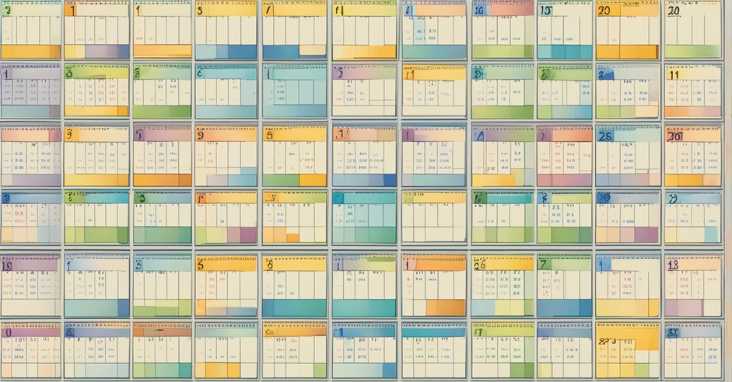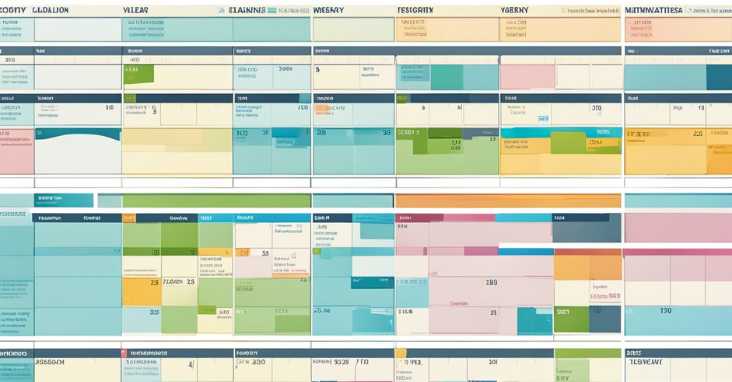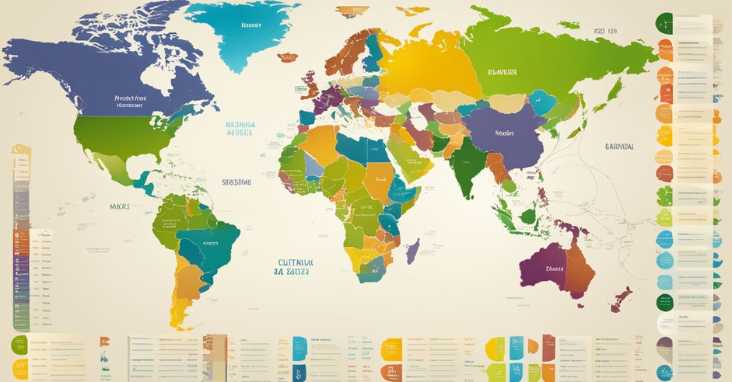How many weeks in a year? A year typically has 52 weeks. However, there’s an extra day (or two in leap years) beyond the 52 full weeks.
Calculating the number of weeks in a year may seem like a simple task, but it can actually be a bit more complicated than one might think. The number of weeks in a year depends on a variety of factors, including the calendar system being used and whether or not it is a leap year. In this article, we will explore the basics of weeks in a year and the various factors that can affect this calculation.

The most widely used calendar system in the world is the Gregorian calendar, which was introduced by Pope Gregory XIII in 1582. This calendar system is based on the solar year, which is the time it takes for the Earth to complete one orbit around the sun. The Gregorian calendar has 365 days in a year, with an additional day added to the calendar every four years to account for the fact that the solar year is actually slightly longer than 365 days. This additional day is known as a leap day and is added to the calendar in February.
Basics of Weeks in a Year
Definition of a Week
A week is a period of seven days. It is used as a standard unit of time in many cultures around the world. Each day of the week has a name, and the seven-day cycle is repeated continuously. The concept of a week has been around for thousands of years and has been used for various purposes, including religious observances, work schedules, and social activities.
Standard Calendar Year
A standard calendar year has 52 weeks. This means that there are 52 weeks in a non-leap year. Each week has seven days, which means that there are 364 days in a year. The first day of the year is usually January 1st, and the last day of the year is December 31st.
Leap Year
A leap year is a year that has an extra day added to it. This extra day is added to the month of February, and it is called a leap day. Leap years occur every four years, with the exception of years that are divisible by 100 but not by 400. In those years, there is no leap day. This means that there are 366 days in a leap year, which is equivalent to 52 weeks and 2 days.
It is important to note that not all weeks in a leap year have the same number of days. The first week of the year, for example, may have only six days, while the last week of the year may have eight days.
To learn more about the basics of weeks in a year, visit timeanddate.com, a reliable source for information on calendars and timekeeping.
Weeks and Days Calculation
Calculating Weeks in a Year
Calculating the number of weeks in a year is a simple process that involves dividing the total number of days in a year by 7. A year has either 365 days or 366 days in a leap year. Therefore, the number of weeks in a year can be calculated as follows:
- For a non-leap year: 365 days ÷ 7 days/week = 52.14 weeks
- For a leap year: 366 days ÷ 7 days/week = 52.29 weeks
It is important to note that the number of weeks in a year is not a whole number. This means that there will always be a fraction of a week left over. To determine the number of days left over, multiply the decimal portion of the week by 7.
Days to Weeks Conversion
Converting days to weeks is a useful calculation when planning schedules or projects that are time-dependent. To convert days to weeks, divide the number of days by 7. For example, if there are 28 days until a deadline, the number of weeks remaining would be 4 weeks (28 ÷ 7 = 4).
It is important to note that when converting days to weeks, any remaining days that do not make up a full week should be accounted for separately. For example, if there are 33 days until a deadline, the number of weeks remaining would be 4 weeks with 5 days left over.
To make these calculations easier, there are many online calculators available that can quickly and accurately convert days to weeks. One such calculator can be found at timecalculator.net.
By understanding how to calculate the number of weeks in a year and how to convert days to weeks, individuals and businesses can better plan and manage their time.
Calendar Systems and Yearly Variations

Gregorian Calendar
The Gregorian calendar is the most widely used civil calendar in the world. It was introduced by Pope Gregory XIII in 1582 and is a reform of the Julian calendar. The Gregorian calendar has 365 days in a year, with an additional day added every 4 years to account for leap years. The leap year occurs every year that is divisible by 4, except for years that are divisible by 100 but not divisible by 400. For example, 2016 was a leap year, but 1900 was not.
January 1st is considered the beginning of the Gregorian calendar year. In the years 2013-2026, each year has 52 weeks plus 1 day, except for leap years which have 52 weeks plus 2 days.
Julian Calendar
The Julian calendar was introduced by Julius Caesar in 45 BC and was the predominant calendar in the Western world until the Gregorian calendar was introduced. The Julian calendar has 365 days in a year, with an additional day added every 4 years to account for leap years.
In the Julian calendar, the year 2013 had 52 weeks plus 1 day, while the years 2014-2020 and 2022-2025 had 52 weeks plus 2 days. The year 2021 had 52 weeks plus 1 day.
Other Calendar Systems
There are many other calendar systems used throughout the world, including the Chinese calendar, Hebrew calendar, and Islamic calendar. Each of these calendars has its own system for calculating the number of days in a year and the number of weeks in a year.
It’s important to note that not all calendars start on January 1st, and not all calendars have a leap year system like the Gregorian and Julian calendars.
For more information on different calendar systems and their variations, visit timeanddate.com, a reputable source for information on calendars and timekeeping.
Week Numbering and Dates
Week Numbering Systems
Week numbering systems vary across different countries and organizations. In some countries, the week starts on Sunday, while in others it starts on Monday. The International Organization for Standardization (ISO) has established a standardized week numbering system known as ISO 8601. This system starts the week on Monday and assigns each week a number from 1 to 52 or 53, depending on the year.
Calculating Week Numbers
Calculating the week number of a specific date can be done using a week number calculator or a dates calculator. These tools take into account the week numbering system being used and the specific date in question. For example, if using the ISO 8601 system, the week number for January 18, 2024 would be 03.
Standardized Week Numbering
ISO 8601 has become the most widely recognized and standardized week numbering system across the globe. It is used by many organizations and businesses to ensure consistency and accuracy in their operations. For instance, the European Union uses ISO 8601 for date and time representation in all of its documents and publications.
To learn more about ISO 8601 and its week numbering system, visit the ISO website
Cultural and Regional Variations

Different cultures and regions have their own ways of measuring time and determining the number of weeks in a year. Here are some examples:
European Calendars
In Europe, the Gregorian calendar is widely used and it consists of 52 weeks in a year. However, some European countries have their own calendars, such as the Julian calendar, which has 52 weeks and 1 day. In addition, some countries have different rules for counting weeks, such as starting the week on a Monday instead of a Sunday.
Asian Calendars
In Asia, there are several different calendars used, such as the Chinese, Hindu, and Islamic calendars. The Chinese calendar has 52 weeks and 1 day, while the Hindu calendar has 52 weeks and 2 days. The Islamic calendar is based on the lunar cycle, and has 50 weeks and 5 or 6 days.
North American Standards
In North America, the standard calendar used is the Gregorian calendar, which has 52 weeks and 1 day. However, there are some variations in the way weeks are counted, such as starting the week on a Sunday instead of a Monday. In addition, there are federal holidays that can affect the number of working days in a year.
It’s worth noting that different regions and countries also have different rules regarding weekends. For example, in some countries, the weekend is on Friday and Saturday, while in others it’s on Saturday and Sunday.
Overall, the number of weeks in a year can vary depending on the calendar used and the region or culture in question. It’s important to be aware of these variations when planning schedules or making travel arrangements.
Here is a useful resource for calculating the number of weeks in a year based on different calendars and starting days of the week.
Astronomical Considerations

Sidereal Year
The sidereal year is the time taken by the Earth to complete one orbit around the Sun, measured with respect to the fixed stars. It is approximately 365.25636 days long. This is because the Earth not only orbits the Sun, but also rotates on its axis, causing a slight shift in its position in space. The sidereal year is important for astronomers, as it is used to measure the position of stars and other celestial objects.
Tropical Year
The tropical year is the time taken by the Earth to complete one orbit around the Sun, measured with respect to the vernal equinox. It is approximately 365.24219 days long. The vernal equinox is the point at which the Sun appears to cross the celestial equator from south to north. The tropical year is important for determining the seasons, as it is used to define the length of a year in most calendars.
Solar Year
The solar year is the time taken by the Earth to complete one orbit around the Sun, measured with respect to the apparent position of the Sun in the sky. It is approximately 365.24 days long. The solar year is important for solar energy applications, as it is used to calculate the amount of energy that can be generated by solar panels.
According to the National Aeronautics and Space Administration (NASA), the length of a year is determined by the time it takes for the Earth to complete one orbit around the Sun. The length of a year can vary slightly depending on the method of measurement used. However, the sidereal, tropical, and solar years are the most commonly used methods.
Practical Applications

Weeks in a Month
Knowing how many weeks are in a year can also help in calculating the number of weeks in a month. Since there are 52 weeks in a year, and 12 months in a year, it can be assumed that there are approximately 4.33 weeks in a month. However, this is not always the case as some months have 4 weeks while others have 5 weeks. For instance, February has 4 weeks, while March has 5 weeks.
To get an accurate number of weeks in a specific month, one can use a calendar or a date calculator. A date calculator can also be used to calculate the number of weeks between two dates, which can be useful in planning events or projects.
Time Measurement
Knowing how many weeks are in a year can also help in understanding time measurement. For instance, there are 60 seconds in a minute, 60 minutes in an hour, 24 hours in a day, 7 days in a week, and 52 weeks in a year. Therefore, there are 31,536,000 seconds in a year (60 x 60 x 24 x 7 x 52).
Understanding time measurement can be useful in various fields such as science, engineering, and finance. For instance, in finance, time measurement is used in calculating interest rates and loan durations.
It is important to note that time measurement can be affected by leap years, which have an extra day (February 29th). Leap years occur every 4 years, except for years that are divisible by 100 but not divisible by 400.
For more information on time measurement, one can refer to the National Institute of Standards and Technology (NIST) website, which provides accurate and reliable information on time and frequency standards.
External Resource
For more information on time measurement, one can refer to the National Institute of Standards and Technology (NIST) website, which provides accurate and reliable information on time and frequency standards.
Frequently Asked Questions

How do you calculate the number of weeks in a typical year?
To calculate the number of weeks in a typical year, one needs to divide the total number of days in a year by 7. This gives a result of approximately 52.14 weeks in a year. However, this number can vary depending on the year.
What is the total count of weeks plus additional days in a year?
A year has 52 weeks and one day. This extra day is added to the calendar every four years to account for the fact that the Earth’s orbit around the sun is not exactly 365 days.
Can a year have more than 52 weeks, and under what circumstances?
No, a year cannot have more than 52 weeks. This is because the number of days in a year is fixed, and each week has seven days. Therefore, the maximum number of weeks in a year is 52.
What are the differences in week count during a leap year?
During a leap year, there are 52 weeks and two days. This is because the extra day added to the calendar is accounted for by adding an extra day to the last week of the year.
How many weeks are there in an academic year for most schools?
The number of weeks in an academic year for most schools varies depending on the country and the school system. In the United States, the typical academic year is around 36 weeks long, while in the United Kingdom, it is around 39 weeks long.
How does the week count vary in a year like 2024, which is a leap year?
In a leap year like 2024, there are 52 weeks and two days. The extra day is added to the last week of the year, which means that the last week of 2024 will have eight days instead of the usual seven.
For more information on the number of weeks in a year, you can visit timeanddate.com, a website with high authority on this topic.













